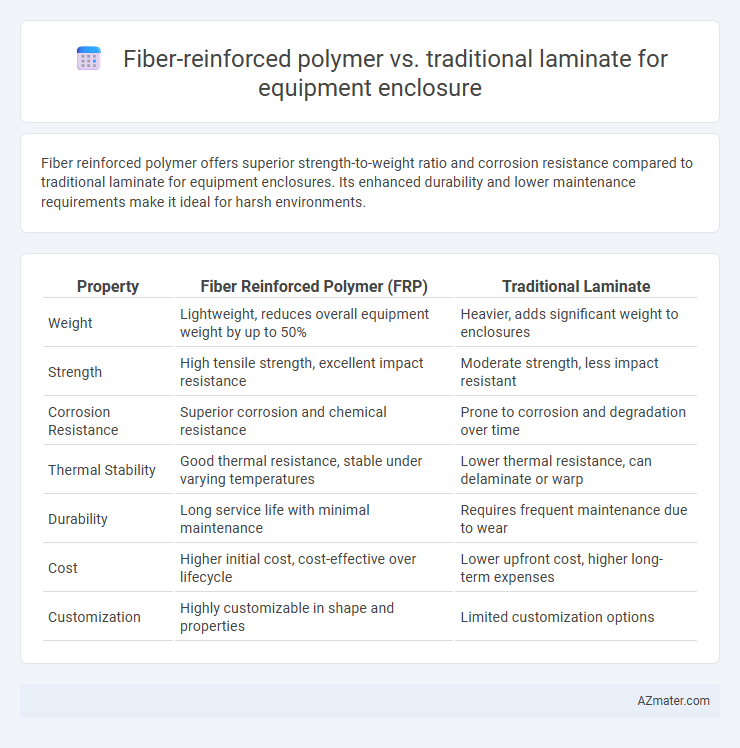Fiber reinforced polymer offers superior strength-to-weight ratio and corrosion resistance compared to traditional laminate for equipment enclosures. Its enhanced durability and lower maintenance requirements make it ideal for harsh environments.
Table of Comparison
| Property | Fiber Reinforced Polymer (FRP) | Traditional Laminate |
|---|---|---|
| Weight | Lightweight, reduces overall equipment weight by up to 50% | Heavier, adds significant weight to enclosures |
| Strength | High tensile strength, excellent impact resistance | Moderate strength, less impact resistant |
| Corrosion Resistance | Superior corrosion and chemical resistance | Prone to corrosion and degradation over time |
| Thermal Stability | Good thermal resistance, stable under varying temperatures | Lower thermal resistance, can delaminate or warp |
| Durability | Long service life with minimal maintenance | Requires frequent maintenance due to wear |
| Cost | Higher initial cost, cost-effective over lifecycle | Lower upfront cost, higher long-term expenses |
| Customization | Highly customizable in shape and properties | Limited customization options |
Introduction to Equipment Enclosures
Fiber reinforced polymer (FRP) offers superior strength-to-weight ratio and corrosion resistance compared to traditional laminate materials used in equipment enclosures. FRP enclosures provide enhanced durability under harsh environmental conditions, reducing maintenance costs and extending service life. Their non-conductive properties improve electrical insulation, making them ideal for protecting sensitive equipment in industrial applications.
Overview of Fiber Reinforced Polymer (FRP)
Fiber Reinforced Polymer (FRP) is a composite material consisting of a polymer matrix reinforced with fibers, typically glass, carbon, or aramid, offering high strength-to-weight ratio and corrosion resistance. FRP enclosures provide superior durability against environmental factors such as moisture, chemicals, and UV exposure compared to traditional laminate materials. These attributes make FRP an ideal choice for equipment enclosures requiring long-term performance and reduced maintenance.
Understanding Traditional Laminate Materials
Traditional laminate materials for equipment enclosures typically consist of layers of resin-impregnated paper or fabric bonded under heat and pressure, offering moderate strength and electrical insulation properties. These laminates, such as phenolic or fiberglass-reinforced phenolic, provide good durability, flame resistance, and cost-effectiveness but may suffer from lower impact resistance and reduced environmental stability compared to fiber reinforced polymer composites. Understanding the mechanical limitations and thermal behavior of traditional laminates is essential for applications requiring long-term reliability and protection in harsh operating conditions.
Mechanical Strength Comparison
Fiber reinforced polymer (FRP) exhibits superior mechanical strength compared to traditional laminate materials in equipment enclosures, offering enhanced impact resistance and higher tensile strength. FRP's composite matrix structure provides better durability under stress and improved resistance to environmental factors such as corrosion and UV exposure. Traditional laminate materials typically have lower flexural strength and are more prone to delamination and mechanical failure under heavy loads or continuous vibration.
Weight and Design Flexibility
Fiber reinforced polymer (FRP) enclosures offer significantly lower weight compared to traditional laminate materials, enhancing portability and ease of installation. FRP provides superior design flexibility due to its moldability, allowing complex shapes and integrated features that are difficult to achieve with traditional laminates. The combination of lightweight properties and versatile design options makes FRP an ideal choice for modern equipment enclosures demanding both performance and customization.
Durability and Environmental Resistance
Fiber reinforced polymer (FRP) offers superior durability and environmental resistance compared to traditional laminate in equipment enclosures, resisting corrosion, moisture, and UV radiation effectively. FRP materials exhibit enhanced impact strength and long-term structural integrity, making them ideal for harsh outdoor or industrial environments. Traditional laminates tend to degrade faster under exposure to chemicals and extreme weather, leading to higher maintenance and replacement costs.
Thermal and Electrical Insulation Properties
Fiber reinforced polymer (FRP) offers superior thermal insulation with low thermal conductivity, effectively reducing heat transfer in equipment enclosures compared to traditional laminate materials. FRP's excellent electrical insulation properties prevent electrical conduction and enhance safety by minimizing the risk of short circuits and electrical faults. In contrast, traditional laminates often exhibit higher thermal conductivity and may require additional insulating layers to achieve comparable electrical insulation performance.
Maintenance and Longevity
Fiber reinforced polymer (FRP) enclosures offer superior corrosion resistance and reduced maintenance compared to traditional laminate options, which are prone to moisture absorption and delamination. The inherent durability and UV resistance of FRP extend equipment enclosure longevity, often surpassing traditional laminates by 50% or more in harsh environments. Lower maintenance costs and fewer repairs make FRP a cost-effective solution for long-term equipment protection.
Cost Analysis: FRP vs Traditional Laminate
Fiber reinforced polymer (FRP) equipment enclosures typically offer a lower total cost of ownership compared to traditional laminate due to their superior durability and reduced maintenance requirements. While the initial investment for FRP may be higher, its resistance to corrosion, chemicals, and environmental factors significantly decreases repair and replacement expenses over time. Traditional laminate enclosures often incur higher lifecycle costs due to susceptibility to moisture damage, warping, and frequent upkeep.
Applications and Industry Recommendations
Fiber reinforced polymer (FRP) offers superior corrosion resistance and lightweight durability, making it ideal for equipment enclosures in harsh industrial environments such as chemical processing plants and marine applications. Traditional laminate enclosures, often constructed from fiberglass or resin composites, provide cost-effective protection in less aggressive settings like telecommunications and electrical control panels. Industry recommendations emphasize selecting FRP for outdoor or corrosive applications due to its longevity and low maintenance, while traditional laminates remain preferred for indoor, budget-sensitive projects.

Infographic: Fiber reinforced polymer vs Traditional laminate for Equipment enclosure
 azmater.com
azmater.com